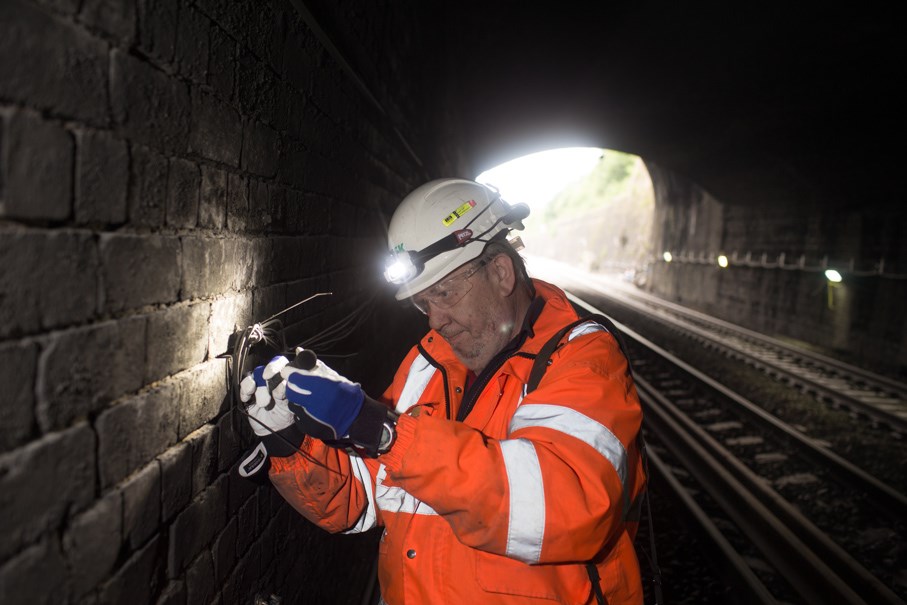Monday 10 Aug 2015
Batman joins forces with Network Rail’s orange army to help deliver Bath electrification work
- Region & Route:
- | Wales & Western: Western
- | Wales & Western
As the ‘orange army’ entered its third week of preparing Bath’s railway line for electrification, the team has been working with an ecologist to ensure the bats living in Box Tunnel are not adversely affected by the work.
Protecting local wildlife is a key element of the project to lower 10km of track through Bath in preparation for the arrival of a new fleet of longer, faster, quieter and greener electric trains.
Before work commenced on site, Network Rail worked with an ecologist to survey the bat population in Box Tunnel to better understand their numbers and patterns of behaviour. This enabled the team to adapt their working practices to cater for the bats.
As the team head towards the halfway point in the project, an ecologist once again visited the site to survey the bat population and check the recording equipment that has been installed in the tunnel to monitor their activity.
Andy Haynes, Network Rail’s project director for the west of England, said: “We have often talked about the importance of preserving Bath’s historic architecture, but as equally important is the need to protect the wildlife that lives within it.
“This is why we are continuing to work with an ecologist to ensure the improvement work we are carrying out is not having a detrimental effect on the significant number of bats that have made Box Tunnel their home.
“So far the bats appear to be disturbed less by our work than they are by the usual passage of trains, which is good news.”
During their work in Box Tunnel, the ‘orange army’ also found a young injured kestrel. After liaising with the Royal Society for the Protection of Birds, the team took the kestrel to a nearby veterinary surgery and it is now recovering well at a bird of prey rescue centre.
Andy continued: “You always encounter the unexpected when working on a complex project such as this, but I’m pleased to say that we remain on schedule and last weekend finished our track lowering work through Dundas Aqueduct.
“I would like to thank passengers and those living near Bath’s railway line, for their continued patience and support as we deliver the biggest upgrade this section of line has had for over 40 years.”
ENDS
Notes to editors
The species of bat identified as roosting in Box Tunnel, include:
- Small numbers of hibernating lesser horseshoes
- A maternity colony of common pipistrelles
- Transient roosts of brown long-eared and Myotis bats
- One male Bechstein’s bat.
Further travel information for during the Bath work can be found by visiting First Great Western’s website www.firstgreatwestern.co.uk. Alternatively, National Rail Enquiries also has up-to-date travel advice on their website www.nationalrail.co.uk.
Contact information
Passengers / community members
Network Rail national helpline
03457 11 41 41
Latest travel advice
Please visit National Rail Enquiries
Journalists
Victoria Bradley
Media relations manager (Western route)
Network Rail
01793 389749 / 07710 938470
victoria.bradley@networkrail.co.uk
About Network Rail
We own, operate and develop Britain's railway infrastructure; that's 20,000 miles of track, 30,000 bridges, tunnels and viaducts and the thousands of signals, level crossings and stations. We run 20 of the UK's largest stations while all the others, over 2,500, are run by the country's train operating companies.
Usually, there are almost five million journeys made in the UK and over 600 freight trains run on the network. People depend on Britain's railway for their daily commute, to visit friends and loved ones and to get them home safe every day. Our role is to deliver a safe and reliable railway, so we carefully manage and deliver thousands of projects every year that form part of the multi-billion pound Railway Upgrade Plan, to grow and expand the nation's railway network to respond to the tremendous growth and demand the railway has experienced - a doubling of passenger journeys over the past 20 years.
Follow us on Twitter: @networkrail
Visit our online newsroom: www.networkrailmediacentre.co.uk

